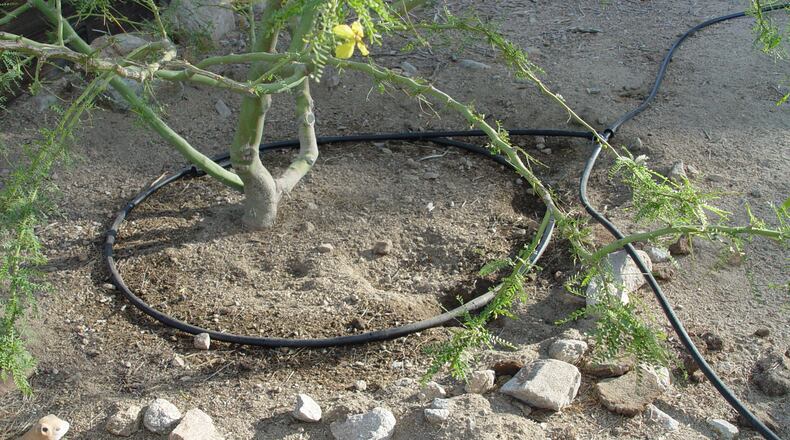The consequences of failure to provide adequate moisture to a mature tree are dieback, borers and diseases spread by insects that flock to struggling plants. With dehydration, the hydrostatic interior pressure falls and natural defenses are lost. This is when opportunists move in to take out your favorite shade tree.
Those who live in areas that did not receive adequate rainfall this year should stay vigilant this summer. Trees already showing drought issues last year will have double trouble this year if not remedied. If you don’t assess your trees and become proactive with hydration, they will not have enough moisture this summer. With trees contributing high property values, you can’t afford to lose them to neglect.
When creating a drip system to replace your old spray heads, there are some important things to remember. The root systems were trained to feed on surface water applied by full coverage spray heads. When you switch to emitters, the water goes deep in a narrow column beneath each emitter. Roots there will grow and feed off that tube of moisture while the rest of the roots may be dry as a bone. Unless you periodically flood that root zone, it will take even longer for new root tips and hairs to form before water can be taken in.
Just imagine the trunk of your tree growing out of the hub of a bicycle wheel. The spokes are all the feeder roots on the surface drawing up water from daily spray irrigation. If you create a ring of drip emitters around your tree like the rim of that bicycle wheel, you can maintain a circular ring of active root growth. This ring keeps all sides of the tree able to take up rainwater or an occasional flooding with living roots. When the system is turned off for the rainy season, it’s easy for the tree to make its transition to absorbing rainfall.
This is why irrigation design and maintenance is the most important aspect of any drought related changes to a landscape. Adequate delivery won’t cut it. Plants need efficient, well designed coverage with quality products you can obtain, repair or replace for many years without failures. Find a good irrigation contractor or gardener with great skills to review your older plants and make sure they’ll be properly watered this summer.
The rush to remove lawns and change our landscapes to a whole new kind of irrigation is not allowing much time to work out the transition effects. All over the West, folks forgot about their trees in the process, perhaps because they once survived on deep ground water. Last summer they started whispering their grievance, If not remedied before high temperatures arrive, they will punish our omission with an unprecedented rate of attrition.
———
Maureen Gilmer is an author, horticulturist and landscape designer. Learn more at www.MoPlants.com
About the Author
